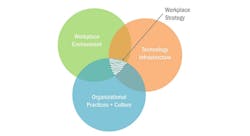Finally! There's a workplace trend that’s worth embracing
In my previous blog post, I examined the question of what are the current workplace trends? I discussed why the typical responses we hear are, frankly, dangerous. To sum it up, when the question is posed, we hear about various progressive workplace solutions. These solutions are great for some, not great for others. So, which workplace trend is worth talking about?
The big trend that I can get behind is this: There’s finally a realization by corporate real estate executives that in order to create a successful workplace, there must be alignment between their people, their place and the tools they have to do their jobs. Solutions are born from understanding your client. Who they are. How they work. What do they need, technologically, to support what they do.
What do I mean by people place and tools?
By People, I mean the organization’s DNA. What is the corporate culture? What is the management style? What are their business goals? What are the work processes? What are the work styles? Is mobility encouraged? What are the demographics? What are the reward systems? Typically, we discover all these things about a company in our visioning and focus group sessions.
Solutions are born from understanding your client. Who they are. How they work. What do they need, technologically, to support what they do.
By Tools, I mean technology. But Tools is about more than the gear in the office, it’s about the overall technological environment, its capability and limitations. Are laptops de rigueur? Or is it an environment where team members are tethered to the desktop via the ball and chain network cable? Is data available to be accessed via Wi-Fi? Are there regulatory and security issues around the data? Can it be accessed anywhere, anytime? How likely are any of these things to change?
As workplace designers, we provide the Place, or environment, that satisfies all we’ve talked about in People and Tools with enough future-proofing to get the organization where it wants to be.
The intersection of these three (People, Place and Tools) is where we find success. Discover that intersection and design to criteria support all three.
How are these related?
If a mobile work style is not possible, for whatever reason, why would we provide a work-setting that satisfies or encourages mobility? If you can’t get up and move, why are we providing alternative work-settings that promote just that? If you’re tethered to your desk with a network cable and can only access your data from your desk, why would we provide a focus room for you to go into to do heads-down, focused computer work? The answer is that we shouldn’t.
Management figures in, too. Take the idea of presence versus performance. If your managers follow an “If I don’t see you, you’re not working” outlook, then having a free address system or areas where you can be internally mobile to do your work as you see fit is just not going to work.
Therefore, when asked about workplace trends, we often hear about solutions. The real trend in the workplace is an increasing understanding from corporate executives for the need to find an appropriate balance and alignment between their people, their tools and the environment in which they work. Ask the right questions. One size does not fit all. Build it and they will change is an unreliable M.O.
About the Author: John Varholak, AIA, IIDA, LEED AP, is a Senior Project Designer with VOA Associates. With over three decades in full service interior architectural design, planning and construction management, Varholak is a highly experienced design leader and expert workplace strategist. He has performed management and design of full service interior architectural, space planning and facility assessments for corporations, government contractors, government agencies, and association and not-for-profit clients. His recent experience includes clients such as Capital One, Airbus, Google, Twitter, USAID, Social & Scientific Systems, USGS, Carlyle Group, and the USDA, among others.
About the Author
Stantec
Published by global design firm Stantec, this eclectic blog features viewpoints, insights, and explanations from Stantec architects, engineers, and designers, on a range of issues impacting the fabric of our communities. Our contributors share their thoughts about design trends, emerging technologies, vexing challenges, and inspired solutions. For more blog posts, visit our Ideas page. Follow us on Facebook, Instagram, LinkedIn, and Twitter, and YouTube.
